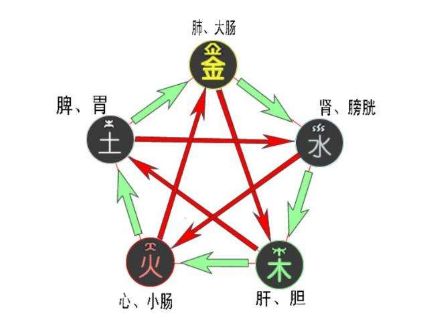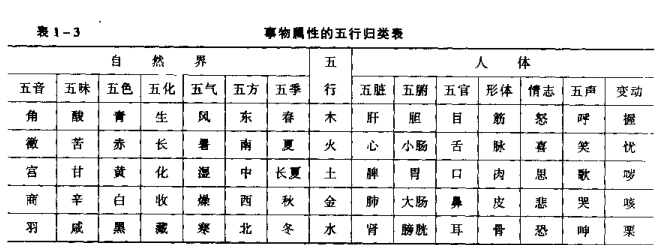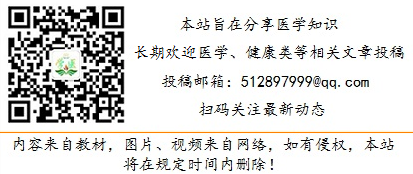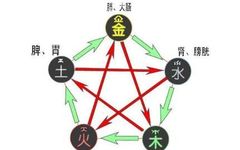
(1) Basic Concept of the Five Elements
The Five Elements, namely Wood, Fire, Earth, Metal, and Water, refer to five fundamental substances and their movements and transformations. The term “Five” in Five Elements indicates the five basic substances that constitute all things in the universe, differentiated from the primordial qi of the cosmos; “Elements” refers to the movements and changes of these five substances. As stated in the “Shang Shu Zheng Yi”: “The five refer to each having its own material and function. The term ‘elements’ indicates that in the heavens, they flow as five qi; on earth, they are the means of existence.” However, from a methodological perspective, the Five Elements have transcended their material concept and evolved into five basic properties that categorize and explain the interrelations of all things in the universe.

The original meaning of the Five Elements is related to the “Five Materials”, referring to the five basic substances or elements: Wood, Fire, Earth, Metal, and Water. The “Zuo Zhuan, Year 27 of Duke Xiang” states: “Heaven produces five materials, which the people utilize; one cannot be discarded.” These five substances are the most common and indispensable materials in human daily production and life. As stated in the “Shang Shu Zheng Yi”: “Water and Fire are what the people consume; Metal and Wood are what the people utilize; Earth is what nourishes all things, serving humanity.” Since humans frequently interact with these five substances in production and life, they recognize their interactions, which can also give rise to new things. As stated in the “Guo Yu, Zheng Yu”: “By mixing Earth with Metal, Wood, Water, and Fire, one can create myriad things.”
The term “Five Elements” first appeared in the “Shang Shu”. The “Shang Shu, Zhou Shu, Hong Fan” states: “Gun blocked the flood, and thus the five elements were revealed.” It abstractly summarizes the characteristics of the Five Elements from a philosophical perspective, indicating: “The first is Water, the second is Fire, the third is Wood, the fourth is Metal, and the fifth is Earth. Water moistens downwards, Fire blazes upwards, Wood bends and stretches, Metal transforms, and Earth nurtures crops.” At this point, the Five Elements have been abstracted from the five specific substances into a rational philosophical concept. Ancient people utilized the abstract characteristics of the Five Elements, employing analogy and deduction to categorize various phenomena and things in nature into five categories, explaining the laws of occurrence, development, and change of various phenomena through the relationships of “mutual generation” and “mutual restraint” among the Five Elements. Therefore, the theory of the Five Elements serves as a worldview and methodology for understanding, explaining, and exploring the laws of cosmic change based on the characteristics and mutual relationships of Wood, Fire, Earth, Metal, and Water.
Traditional Chinese Medicine (TCM) applies the theory of the Five Elements to the medical field, using it to elucidate the organic connections between parts of the human body, between parts and the whole, and between the surface and internal organs, as well as the unity of the human body with the external environment. The theory of the Five Elements, as a method of thinking, permeates all aspects of TCM theoretical systems, explaining the physiological and pathological conditions of the human body and guiding the diagnosis and treatment of diseases, thus becoming an essential component of TCM theoretical systems.
(2) Characteristics of the Five Elements
The characteristics of the Five Elements are rational concepts gradually formed through the ancient people’s intuitive observations and basic understanding of the five substances—Wood, Fire, Earth, Metal, and Water—based on long-term life and production practices. It serves as the fundamental basis for identifying the properties of various things according to their Five Element attributes. Generally, it is believed that the classic summary of the characteristics of the Five Elements is found in the “Shang Shu, Hong Fan”: “Water moistens downwards, Fire blazes upwards, Wood bends and stretches, Metal transforms, and Earth nurtures crops.”
The characteristics are described as follows:
“Wood bends and stretches”: “Bend” means to curve; “Stretch” means to extend. Bending and stretching refer to the characteristics of tree branches that grow, are flexible, and can both bend and extend, extending to all things and phenomena that possess properties or functions of growth, upward movement, and smoothness, which belong to Wood.
“Fire blazes upwards”: “Blaze” refers to burning, heat, and brightness; “Upwards” means to rise. Blazing upwards indicates that Fire possesses the characteristics of heat, rising, and brightness. This extends to all things and phenomena that have properties or functions of warmth, upward movement, and brightness, which belong to Fire.
“Earth nurtures crops”: “Nurture” is synonymous with “day”; “Crops” refers to the planting of grains; “Harvest” refers to the gathering of grains. Nurturing crops generally refers to human agricultural activities of planting and harvesting grains. This extends to all things and phenomena that possess properties or functions of nurturing, bearing, and receiving, which belong to Earth. Hence, it is said that “Earth bears the four actions”, “All things are born from Earth”, “All things perish in Earth”, and “Earth is the mother of all things”.
“Metal transforms”: “Transform” means to follow; “Transform” refers to change. This indicates that Metal has the nature of both hardness and softness: although Metal is hard and can be made into weapons for killing, it also possesses a gentle nature that can change according to human will. This extends to all things and phenomena that have properties or functions of sinking, killing, and gathering, which belong to Metal.
“Water moistens downwards”: “Moisten” means to nourish; “Downwards” means to flow down. Moistening downwards indicates that Water possesses the characteristics of nourishing and flowing downwards. This extends to all things and phenomena that have properties or functions of nourishing, flowing downwards, coldness, and concealment, which belong to Water.
From the above characteristics of the Five Elements, it can be seen that the Wood, Fire, Earth, Metal, and Water in the theory of the Five Elements are no longer just the five specific substances themselves, but rather a summary of the different properties of these five substances.
(3) Classification of Things and Phenomena by the Five Elements
The theory of the Five Elements classifies various things and phenomena in nature based on the characteristics of each element, thereby constructing a system of Five Elements. The methods of classifying things and phenomena according to the Five Elements mainly include the methods of analogy and deduction. The analogy method involves finding unique characteristics that reflect the essence from the image (form, function, properties) of things; “Comparison” means comparing the abstract properties of each of the Five Elements with the unique characteristics of a certain thing to determine its elemental affiliation. If a certain feature of a thing is similar to the characteristics of Wood, it is classified as Wood; if it is similar to Water, it is classified as Water; and so on. For example, the directions correspond to the Five Elements: the rising sun in the East, similar to the upward characteristic of Wood, thus the East belongs to Wood; the heat in the South, similar to the characteristics of Fire, thus the South belongs to Fire; the setting sun in the West, similar to the sinking characteristic of Metal, thus the West belongs to Metal; the cold in the North, similar to the characteristics of Water, thus the North belongs to Water; the fertile land in the Central region, flourishing with all things, similar to the characteristics of Earth, thus the Center belongs to Earth.
The deduction method involves inferring and summarizing the elemental affiliations of other related things based on the known elemental affiliations of certain things. For example, it is known that the Liver belongs to Wood (major premise), and since the Liver is associated with the Gallbladder, governs the tendons, manifests in the nails, and opens to the eyes (minor premise), it can be inferred that the Gallbladder, tendons, nails, and eyes all belong to Wood; similarly, the Heart belongs to Fire, thus the Small Intestine, pulse, face, and tongue are related to the Heart, hence they also belong to Fire; the Spleen belongs to Earth, thus the Stomach, muscles, lips, and mouth are related to the Spleen, hence they also belong to Earth; the Lung belongs to Metal, thus the Large Intestine, skin, hair, and nose are related to the Lung, hence they also belong to Metal; the Kidney belongs to Water, thus the Bladder, bones, hair, ears, and two Yin are related to the Kidney, hence they also belong to Water.
The theory of the Five Elements uses the characteristics of the Five Elements as a basis, employing analogy and deduction to categorize the myriad forms and changes of things and phenomena in nature into the five categories of Wood, Fire, Earth, Metal, and Water. Each category of things and phenomena shares specific attributes that establish certain connections. Under the guidance of the concept of the correspondence between heaven and humanity, TCM centers around the Five Elements, using the spatial structure of the five directions, the temporal structure of the five seasons, and the structural framework of the five organs in the human body to categorize various things and phenomena in nature and the physiological and pathological phenomena of the human body according to their attributes. This connects the life activities of the human body with the things or phenomena in the natural world, forming a Five Element structural system that links the internal and external environments of the human body.


| Recommended Reading: | |
| Internal Medicine | Symptoms and Signs |
| Pediatrics | Practical Skills |
| Obstetrics and Gynecology | Emergency Knowledge |



